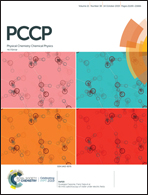First-principles investigation of the hydrogen evolution reaction on different surfaces of pyrites MnS2, FeS2, CoS2, NiS2†
Abstract
We theoretically investigated hydrogen evolution reaction (HER) on the XRD observed (100), (110), (111), and (210) surfaces of pyrite structure CoS2. The random structure searching method was employed in this work to thoroughly and less-biasedly identify the active sites for each considered surface. We calculated the free energy of hydrogen adsorption, and found that (110) and (210) surfaces are more active than the conventionally assumed (100) facet. While the lowest energy active site on the (100) and (210) surfaces is the five-coordinated transition metal site that is commonly seen in other HER catalysts, the lowest energy active site on the (110) surface is the two-coordinated S site, which is a S tetrahedron with two corners missing. Besides those lowest energy active sites, both (110) and (210) have more than one species of active site on the surface, including not fully coordinated transition metals and sulfur. We further explored the reaction for MnS2, FeS2, and NiS2, and analyzed the density of states. Our results showed both CoS2 and NiS2 (110) and (210) surfaces are catalytically reactive for HER.



 Please wait while we load your content...
Please wait while we load your content...